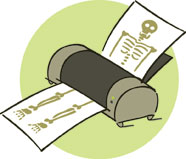Insights (page 4)
Knee bones's connected to the... ink-jet printer?

Doctors, in dealing with someone in need of a bone graft, have been forced to rely on ceramics or on harvesting bone from other parts of the body in treating their patients.
In the near future, all they might have to do is fire up their ink-jet printers.
A McGill dentistry professor has developed a technique to use the common office technology to create three-dimensional bio-ceramic bones using the same materials found in the real thing.
“We’re a long way from seeing this method used in a hospital setting, but it’s an important first step toward a revolutionary change in bone-grafting technology,” says Jake Barralet, McGill’s Canada Research Chair in Osteoinductive Biomaterials.
Barralet, working with researchers from Université Laval and the University of Würzburg in Germany, has taken advantage of the ink-jet printer’s ability to print layer upon layer.
“It’s similar to a CT scan, in that the image is created one layer at a time. The result is three-dimensional,” says Barralet. “Rather than printing on paper, we’re printing on a bed of cement powder using an acid instead of ink, which reacts with the cement to print whatever pattern we want.”
According to Barralet, these artificial bone sections, composed mostly of calcium phosphate, can be very precisely constructed, with holes designed in the artificial grafts helping to guide the growth patterns of new bone in patients, serving, in effect, as biodegradable scaffolds for regrowing bones.
Barralet’s team has successfully cleared one crucial hurdle. They’ve proven that a network of blood vessels can be encouraged to grow in their implants.
“Before you can get bone, you need a blood supply,” Barralet observes.
Barralet believes that the new process his research team has devised might eventually be used in reconstructive surgery or other types of bone repair, and could be much more effective and less risky than harvesting sections of bone from elsewhere in the body to use in bone grafting.
When lifespan is a black and white issue
African Americans in the United States are living longer lives — but they’re still, on average, far less likely to live as long as their Caucasian compatriots.

That finding comes courtesy of a study recently published by postdoctoral research fellow Sam Harper and Professor John Lynch, both from the Department of Epidemiology, Biostatistics and Occupational Health. The pair examined 46 million death certificates in the U.S. , spanning 20 years, to arrive at their conclusions.
After crunching numbers, Harper and Lynch found that overall life expectancy for American blacks is catching up to that for the white population. Driven by drops in mortality from HIV, homicide and cardiovascular disease, the gap between the two groups is at historic lows.
That’s the good news. The bad news is that life expectancy for black men in the U.S. is still six and a half years less than it is for white men. For black women, the gap is four and a half years.
Harper says that the research offers hope that there could be further improvement in life expectancy rates for blacks in the U.S.
“We found that cardiovascular disease explained about 30 per cent of the existing gap for men and about 40 per cent for women. Our study suggests applying what we already know about cardiovascular disease to try and remedy this gap.”


